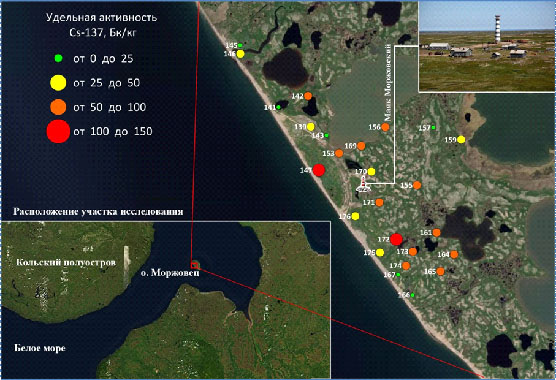Soil technogenic radioactivity in the vicinity of the Morzhovets Lighthouse (the Morzhovets Island, Archangelsk region)
DOI:
https://doi.org/10.31251/pos.v5i4.193Keywords:
technogenic radioactivity; illuvial-humus peaty podbur (Gleyic Histic Entic Podzol); gleyic peat-bog soil (Fibric Histosols (Gleyic)); 137Cs; Morzhovets Island; Morzhovets Lighthouse; Arkhangelsk regionAbstract
The aim of the study was to assess soil technogenic radioactivity in the vicinity of the Morzhovets Lighthouse and surrounding areas by measuring radio caesium (137Cs) specific activity.
Location and time of the study. Field work was performed in the area around the Morzhovets Lighthouse (the Morzhovets Island, Archangelsk region) in summer 2022.
Methods. Soil samples were collected at 26 sites from the 0-5 cm layer, of which at 12 sites soil samples were collected also from 5-10 и 10-20 cm layers. Aboveground phytomass was sampled as well. In the laboratory the soil samples were air-dried and placed in the Marinelli vessel for measuring 137Cs specific activity by gamma-spectrometry. Registration of the gamma-radiation from the measured soil sample, as well as processing of the obtained spectra were performed using the Progress-gamma software and hardware complex FVKM.412131.002-03. The energy calibration of the gamma spectrometer to control the safety of the setup parameters was carried out after each measurement using a combined control source OISN-137-1 in a Marinelli vessel. The minimal exposure time of the study sample was 3600 sec; however, the time was increased for some samples with low activity.
Results. The territory of the Morzhovets Island is occupied by the lowland seaside terraced plane landscapes with tundra vegetation on the illuvial-humus peaty podbur, alternating with mires, and gleyic peat-bog soils. Caesium specific radioactivity in the top 0-5 cm soil layer, represented by poorly decomposed peat horizon, was found to vary from 9.4 to 144.5 Bq/kg in the illuvial-humus peaty podbur (Gleyic Histic Entic Podzol) and from 12.2 to 139.4 Bq/kg in the gleyic peat-bog soils (Fibric Histosols (Gleyic)). The radio caesium specific activity was shown to decrease sharply with soil depth, reaching the 3 Bq/kg detection limit of the gamma-spectrometer. Comparative analysis of the data showed that in the West Arctic sector 137Cs specific activity decreases from the east to the west, with increasing distance from the Novaya Zemlya, from 80.2 Bq/kg (the Novaya Zemlya Archipelago) and 80.7 Bq/kg (Bolshezemelskaya Tundra) to 19. 2 Bq/kg (the Svalbard Island).
Conclusions. The 137Cs distribution in soil of the Morzhovets Island showed the persistent fixation of the element by the upper 5 cm-thick organic part of the soil profile, representing the primary biogeochemical barrier. The vegetation does not accumulate technogenic radioactivity. Overall, the 137Cs distribution in soils around the Morzhovsky Lighthouse displays a medley pattern. The maximal 137Cs specific activity values were measured both in the illuvial-humus peaty podbur and gleyic peat-bog soils.
Downloads

Downloads
Published
How to Cite
Issue
Section
License
Copyright (c) 2022 The Journal of Soils and Environment

This work is licensed under a Creative Commons Attribution 4.0 International License.






